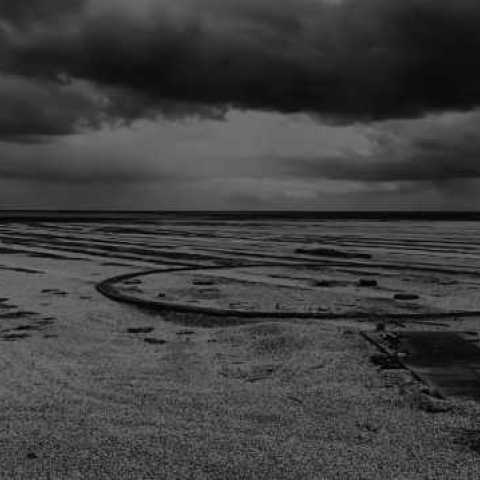Cross Lane Projects
Cross Lane
Kendal
LA9 5LB
United Kingdom

The Accurate Perception Available When Our Eye Becomes Single
7 OCTOBER – 12 November 2022
A new immersive multi-screen installation is opening at Cross Lane Projects, Kendal, this Autumn.
‘The Accurate Perception Available When Our Eye Becomes Single’ is an immersive multi-screen installation evoking the emotional specifics of place, while exploring the elasticity of time and history. It is an audio-visual collaboration between artists Richard Ducker (video) and Ian Thompson (sound) with no linear narrative; sound and image are not synchronised, so each viewing is a unique experience.
The place is Orford Ness on the Suffolk coast, an eight-kilometre shingle spit, used for secret military testing during the First World War until the Cold War in the 1980s. The site is now desolate but the decaying architecture from seventy years of military occupation remain. These strange elemental structures are formed out of an alien landscape that resembles a lost movie set.
To capture Orford Ness’s eerie sense of dislocation, most of the imagery is filmed very slowly in black and white as if watching a still image in motion; one of the histories of the site was the development of fast film techniques for capturing bombing runs. Intercut with this are sections in colour, shot with a handheld smartphone camera and telephoto lens as a deliberate counterpoint, inviting the viewer to slowly absorb the extraordinary landscape and ruined buildings that appear like post-apocalyptic ancient burial sites.
The film’s slow tempo sustains a narrative tension without ever revealing it, inducing a sense of curiosity. The telephoto shots, by contrast, suggest a sniper’s view through the sight of a gun looking for targets, or information, revealing details of the place in the process.
The soundtrack is composed of prevailing features in the Orford Ness soundscape: sea, stones, structures. It accompanies the imagery, but not as a synchronised score. As such, sound and image combine to create constantly shifting counterpoints and the whole space is activated as part of the exhibition. The sonic elements characterize a specific sense of place before, during, and after military occupation, expressing the relative permanence of the Ness and its soundscape heard across many centuries.
For the installation, the film’s constituent parts are broken into seven looped sections and projected on multiple screens and monitors, with four stereo audio channels on loudspeakers.
The film includes performance by artist Sarah Sparkes, in costume as part mythical creature, part out-of-time character. She appears incidentally, unexplained, like an avatar, contrasting mythology with military. This mythical figure has somehow become displaced on the Ness, a lost Godzilla out of place in the strangeness of this part of the Suffolk coastline. The figure is seen coming out of the sea and so also references the strange account of the Orford Ness Merman that is part of local folklore.
It is here too that British atomic bomb detonators were tested. Just along the coast from Orford Ness is Sizewell B nuclear power station. There is a close link between the two sites; the early development of the atomic bomb, and the plutonium produced for civil power that dominated the cold war. This is the dark side of the era’s notion of heroic scientific / technological developments which culminated in the Space Race.
The first radar was also developed at the site, and later, conspiracy theories of alien visitors and UFO sightings in nearby Rendlesham Forest began to appear. The site and its hinterland are often referred to as Britain’s Roswell.
The title of the installation, The Accurate Perception Available When Our Eye Becomes Single, is taken from the writings of the religious cult Heaven’s Gate, connecting the area’s UFO sightings to the paranoia of conspiracy theories.
It is this conflation of the military, science, and myth which establishes the strange dislocation and eeriness of the place and constitutes the meaning of the work, while the buildings, landscape, and soundscape are its subject. It is about the site and its sense of detachment in time and, with nationalism on the rise, its past echoing into our future.
About the artists
Richard Ducker’s practice as a visual artist has brought together a wide variety of processes: sculpture-installation, sound, wall text, and video that suggest narratives of displacement and engender a sense of ‘wrong place, wrong time'. Over the last 3 years Ducker’s practice has moved almost exclusively into film-making, developing some of the themes from my installations.
Ian Thompson is a Senior Lecturer at the University of Greenwich, London, teaching sound design and production across film and digital arts programmes. He’s a member of the SOUND/IMAGE research group, with interests in; spatial audio, sound design in virtual production, soundscape research, and environmental sound recording. His current creative practice with sound extends from musical performance, including recent ‘cello improvisation with various ensembles, and bass guitar with a high-profile commercial group.
About Cross Lane Projects
Established in 2018 by artists Rebecca Scott and Mark Woods, Cross Lane Projects brings new contemporary art to Cumbria. Situated in a former Kendal Mint Cake factory in central Kendal, Cross Lane Projects presents a curated programme of exhibitions by local, international and British artists. Each exhibition is accompanied by a programme of talks and events that aim to create dialogue in all areas of contemporary art.
Founder Scott was raised in Cumbria and lived her formative years as an artist in London. Since returning to Cumbria her intention, alongside partner Woods, is to develop and nurture artistic networks in the area by exhibiting a diverse range of artists from London and beyond.
